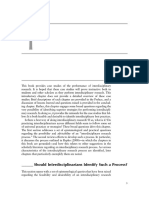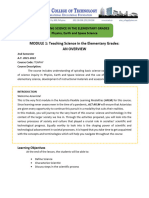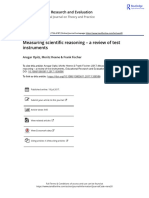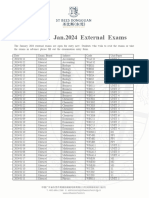Science
Uploaded by
ADRIMISIN, John Kenneth S.Science
Uploaded by
ADRIMISIN, John Kenneth S.Title: Unraveling the Wonders: A Comprehensive Exploration of the Science Thesis
Introduction
The pursuit of knowledge in the realm of science is a journey that transcends
boundaries, unlocking the secrets of the universe and pushing the frontiers of human
understanding. A science thesis represents the culmination of this intellectual odyssey,
encapsulating the rigor, creativity, and innovation that define scientific inquiry. In this
article, we embark on an in-depth exploration of the science thesis, unraveling its
structure, significance, challenges, and the transformative impact it can have on the
scientific landscape.
I. Choosing the Path: Selecting a Science Thesis Topic
Passion and Relevance: The Heart of the Matter
The journey of a science thesis begins with the careful selection of a topic. While
personal passion and interest are crucial, the relevance of the chosen topic to the
broader scientific community cannot be overstated. A compelling science thesis
not only advances knowledge but also addresses pressing questions or
challenges within a specific field.
Interdisciplinary Exploration: Bridging Knowledge Gaps
Science is inherently interconnected, and the most impactful theses often emerge at
the intersection of multiple disciplines. Researchers are encouraged to explore
interdisciplinary approaches, weaving together insights from diverse fields to
address complex problems and foster a holistic understanding of phenomena.
II. Structuring the Science Thesis: From Hypothesis to
Conclusion
A well-structured science thesis follows a logical progression, guiding the reader
through the researcher's exploration, experimentation, and analysis. The components of
a science thesis typically include:
Introduction: Framing the Inquiry
The introduction sets the stage for the research by providing background
information, articulating the research question or hypothesis, and highlighting the
significance of the study. It serves as a roadmap, offering readers a clear
understanding of the research's context and objectives.
Literature Review: Navigating the Scientific Landscape
A thorough literature review is integral to a science thesis, offering a comprehensive
survey of existing research related to the chosen topic. This section not only
demonstrates the researcher's familiarity with prior work but also identifies gaps
in knowledge that the thesis aims to fill.
Methodology: Designing the Experiment
The methodology section details the research design, materials, and procedures
employed to investigate the research question. Clarity and precision are
paramount, as this section serves as a guide for other researchers seeking to
replicate or build upon the study.
Results: Unveiling the Findings
The results section presents the raw data obtained from experiments or
observations. This may include tables, figures, graphs, and statistical analyses. A
clear and objective presentation of results is crucial, laying the foundation for
subsequent interpretation and discussion.
Discussion: Interpreting the Data
The discussion section delves into the interpretation of results, connecting findings
to the broader scientific context. Researchers analyze patterns, draw
conclusions, and explore the implications of their work. Addressing limitations
and potential areas for further research adds depth to the discussion.
Conclusion: Synthesizing the Journey
The conclusion synthesizes the key findings, revisits the research question or
hypothesis, and outlines the broader implications of the study. Researchers may
reflect on the significance of their work, discuss practical applications, and
suggest avenues for future research.
III. Challenges Along the Scientific Odyssey
Experimental Rigor: Navigating Methodological Challenges
Maintaining experimental rigor is a perennial challenge in scientific research.
Researchers must design experiments that are reproducible, control for
confounding variables, and employ statistical methods that withstand scrutiny.
Addressing these challenges ensures the validity and reliability of the study's
results.
Literature Review Pitfalls: Balancing Breadth and Depth
While a comprehensive literature review is essential, striking the right balance
between breadth and depth can be challenging. Researchers must avoid
succumbing to the vastness of the scientific literature and focus on synthesizing
key insights that directly inform the research question.
Data Analysis and Interpretation: Unraveling Complexity
Analyzing complex datasets and interpreting results require advanced statistical and
analytical skills. Researchers often grapple with the nuances of statistical
methods, ensuring that their interpretations are both accurate and meaningful.
Collaborating with statisticians or experts in data analysis can be invaluable.
Time Management: Navigating Research Timelines
The research process, from conceptualization to data collection and analysis, is
time-consuming. Effective time management is crucial to ensuring that the
science thesis progresses within established timelines. Delays may arise due to
unforeseen challenges, emphasizing the need for flexibility and adaptability.
IV. Impact and Contributions of a Science Thesis
Advancing Scientific Knowledge: Adding to the Canon
At its core, a science thesis is a contribution to the collective body of scientific
knowledge. Whether it involves groundbreaking discoveries, innovative
methodologies, or novel interpretations, the thesis adds a unique chapter to the
ongoing narrative of human understanding.
Publication and Dissemination: Sharing Insights with the World
Many science theses evolve into published papers, disseminating findings to the
global scientific community. Publication not only validates the research but also
allows other researchers to build upon the work, fostering a collaborative and
cumulative approach to scientific inquiry.
Real-World Applications: Bridging Theory and Practice
The practical applications of scientific research are a testament to its real-world
impact. A science thesis that identifies solutions to real-world problems or
informs decision-making processes has the potential to influence policies,
improve technologies, and enhance the quality of life.
V. Interdisciplinary Nature of Modern Science Theses
Collaboration Across Disciplines: Breaking Down Silos
Modern scientific challenges often require collaborative efforts across disciplines.
Science theses that embrace interdisciplinary approaches can provide holistic
solutions to complex problems, addressing multifaceted issues that cannot be
confined to a single field of study.
Integration of Technology: Enhancing Research Capabilities
The integration of cutting-edge technologies, such as artificial intelligence, machine
learning, and advanced imaging techniques, has transformed the landscape of
scientific research. Science theses that leverage these technologies demonstrate
an adaptive and forward-thinking approach to inquiry.
Ethical Considerations: Navigating the Intersection of Science and Society
The interdisciplinary nature of modern science necessitates a heightened awareness
of ethical considerations. Researchers must navigate the intersection of science
and society, considering the social, environmental, and cultural impacts of their
work. Ethical research practices ensure the responsible advancement of
knowledge.
VI. The Future of Science Theses: Embracing Innovation
Open Science Practices: Fostering Transparency and Collaboration
Open science practices, including transparent data sharing, collaborative research
platforms, and open-access publications, are shaping the future of scientific
inquiry. Science theses that embrace openness contribute to a culture of
transparency, accelerating the pace of discovery.
Citizen Science Initiatives: Engaging the Public in Research
Citizen science initiatives involve the public in scientific research, democratizing the
research process and expanding the reach of inquiry. Science theses that
incorporate citizen science principles demonstrate a commitment to inclusivity
and community engagement.
Global Challenges: Addressing Grand Challenges Through Science
The future of science theses will likely see an increasing focus on addressing global
challenges, including climate change, public health crises, and sustainable
development. Interdisciplinary collaborations, technological innovations, and
ethical considerations will be central to tackling these complex issues.
You might also like
- A Manifesto For Performative Research: Brad HasemanNo ratings yetA Manifesto For Performative Research: Brad Haseman9 pages
- Q1. What Do You Understand About Inter-Disciplinary Research?No ratings yetQ1. What Do You Understand About Inter-Disciplinary Research?17 pages
- The Drivers of Interdisciplinary ResearchNo ratings yetThe Drivers of Interdisciplinary Research16 pages
- Assignment 1: DEVC 208: Communication of Scientific and Technical InformationNo ratings yetAssignment 1: DEVC 208: Communication of Scientific and Technical Information8 pages
- The Importance and Development of Research Problem: A Didactic DiscussNo ratings yetThe Importance and Development of Research Problem: A Didactic Discuss10 pages
- What Is Research?: Module 01: Introduction To Research and Research in Architecture JGPL2014No ratings yetWhat Is Research?: Module 01: Introduction To Research and Research in Architecture JGPL20147 pages
- Szostak, R. The Intersdispnarity Research ProcessNo ratings yetSzostak, R. The Intersdispnarity Research Process18 pages
- Llamasares - Jodie Mid-Term Exam 7-7-2023No ratings yetLlamasares - Jodie Mid-Term Exam 7-7-20238 pages
- The Importance and Development of Research Problem: A Didactic DiscussNo ratings yetThe Importance and Development of Research Problem: A Didactic Discuss10 pages
- Introduction to Research Methodology by Dr Stephenson Nkurikiyimana @Ayii UniversityNo ratings yetIntroduction to Research Methodology by Dr Stephenson Nkurikiyimana @Ayii University89 pages
- DIPLOMA IN TEACHER EDUCATION RESEARCH SKILLS 2024 NOTESNo ratings yetDIPLOMA IN TEACHER EDUCATION RESEARCH SKILLS 2024 NOTES36 pages
- An Academic Research Publishing Checklist: Brian WhitworthNo ratings yetAn Academic Research Publishing Checklist: Brian Whitworth12 pages
- Advantages of Literature Review in Research100% (1)Advantages of Literature Review in Research5 pages
- Understanding Research Paradigm 25-03-20!16!31 03No ratings yetUnderstanding Research Paradigm 25-03-20!16!31 0322 pages
- Start in The Name of ALLAH ALMIGHTY: "Research Methodologies - Me5703"No ratings yetStart in The Name of ALLAH ALMIGHTY: "Research Methodologies - Me5703"27 pages
- Sujay Devising Smoking Gun Tests for Objectivity FINAL FINAL FINAL FINAL FINALNo ratings yetSujay Devising Smoking Gun Tests for Objectivity FINAL FINAL FINAL FINAL FINAL24 pages
- Lesson 1 Understanding The Basics of Qualitative ResearchNo ratings yetLesson 1 Understanding The Basics of Qualitative Research2 pages
- Measuring Scientific Reasoning A Review of Test InstrumentsNo ratings yetMeasuring Scientific Reasoning A Review of Test Instruments25 pages
- Lohana Schools: P.2 English Revision Work Activity One: 2020No ratings yetLohana Schools: P.2 English Revision Work Activity One: 20209 pages
- 101 American Idiom - Understanding and Speaking English Like An A33% (3)101 American Idiom - Understanding and Speaking English Like An A31 pages
- Comparative Analysis of Harmonic Reduction of VSI Fed Induction Motor Using SVPWM and Sinusoidal PWMNo ratings yetComparative Analysis of Harmonic Reduction of VSI Fed Induction Motor Using SVPWM and Sinusoidal PWM5 pages
- COT DLP FILIPINO6 - ROMA-Wastong Paggamit NG Pang-Angkop at Pangatnig FINALNo ratings yetCOT DLP FILIPINO6 - ROMA-Wastong Paggamit NG Pang-Angkop at Pangatnig FINAL25 pages
- NWU - ACA - 010 Syllabus Pagpapahalagang Pampanitikan100% (1)NWU - ACA - 010 Syllabus Pagpapahalagang Pampanitikan11 pages
- Effect of E - Learning On Student'S Academic Performance at College LevelNo ratings yetEffect of E - Learning On Student'S Academic Performance at College Level5 pages
- Complete Core Competencies of Relational Psychoanalysis A Guide To Practice Study and Research 1st Edition Roy E. Barsness PDF For All Chapters100% (3)Complete Core Competencies of Relational Psychoanalysis A Guide To Practice Study and Research 1st Edition Roy E. Barsness PDF For All Chapters62 pages
- Student Industrial Attachment Report by Muthama David .M. S11/21490/14No ratings yetStudent Industrial Attachment Report by Muthama David .M. S11/21490/147 pages
- What Are The Expected Tasks You Have Successfully Accomplished67% (18)What Are The Expected Tasks You Have Successfully Accomplished1 page
- Certificate Achievement: Sample Learner 120 Hour Advanced TEFL CourseNo ratings yetCertificate Achievement: Sample Learner 120 Hour Advanced TEFL Course1 page
- A Manifesto For Performative Research: Brad HasemanA Manifesto For Performative Research: Brad Haseman
- Q1. What Do You Understand About Inter-Disciplinary Research?Q1. What Do You Understand About Inter-Disciplinary Research?
- Assignment 1: DEVC 208: Communication of Scientific and Technical InformationAssignment 1: DEVC 208: Communication of Scientific and Technical Information
- The Importance and Development of Research Problem: A Didactic DiscussThe Importance and Development of Research Problem: A Didactic Discuss
- What Is Research?: Module 01: Introduction To Research and Research in Architecture JGPL2014What Is Research?: Module 01: Introduction To Research and Research in Architecture JGPL2014
- The Importance and Development of Research Problem: A Didactic DiscussThe Importance and Development of Research Problem: A Didactic Discuss
- Introduction to Research Methodology by Dr Stephenson Nkurikiyimana @Ayii UniversityIntroduction to Research Methodology by Dr Stephenson Nkurikiyimana @Ayii University
- DIPLOMA IN TEACHER EDUCATION RESEARCH SKILLS 2024 NOTESDIPLOMA IN TEACHER EDUCATION RESEARCH SKILLS 2024 NOTES
- An Academic Research Publishing Checklist: Brian WhitworthAn Academic Research Publishing Checklist: Brian Whitworth
- Start in The Name of ALLAH ALMIGHTY: "Research Methodologies - Me5703"Start in The Name of ALLAH ALMIGHTY: "Research Methodologies - Me5703"
- Sujay Devising Smoking Gun Tests for Objectivity FINAL FINAL FINAL FINAL FINALSujay Devising Smoking Gun Tests for Objectivity FINAL FINAL FINAL FINAL FINAL
- Lesson 1 Understanding The Basics of Qualitative ResearchLesson 1 Understanding The Basics of Qualitative Research
- Measuring Scientific Reasoning A Review of Test InstrumentsMeasuring Scientific Reasoning A Review of Test Instruments
- Lohana Schools: P.2 English Revision Work Activity One: 2020Lohana Schools: P.2 English Revision Work Activity One: 2020
- 101 American Idiom - Understanding and Speaking English Like An A101 American Idiom - Understanding and Speaking English Like An A
- Comparative Analysis of Harmonic Reduction of VSI Fed Induction Motor Using SVPWM and Sinusoidal PWMComparative Analysis of Harmonic Reduction of VSI Fed Induction Motor Using SVPWM and Sinusoidal PWM
- COT DLP FILIPINO6 - ROMA-Wastong Paggamit NG Pang-Angkop at Pangatnig FINALCOT DLP FILIPINO6 - ROMA-Wastong Paggamit NG Pang-Angkop at Pangatnig FINAL
- NWU - ACA - 010 Syllabus Pagpapahalagang PampanitikanNWU - ACA - 010 Syllabus Pagpapahalagang Pampanitikan
- Effect of E - Learning On Student'S Academic Performance at College LevelEffect of E - Learning On Student'S Academic Performance at College Level
- Complete Core Competencies of Relational Psychoanalysis A Guide To Practice Study and Research 1st Edition Roy E. Barsness PDF For All ChaptersComplete Core Competencies of Relational Psychoanalysis A Guide To Practice Study and Research 1st Edition Roy E. Barsness PDF For All Chapters
- Student Industrial Attachment Report by Muthama David .M. S11/21490/14Student Industrial Attachment Report by Muthama David .M. S11/21490/14
- What Are The Expected Tasks You Have Successfully AccomplishedWhat Are The Expected Tasks You Have Successfully Accomplished
- Certificate Achievement: Sample Learner 120 Hour Advanced TEFL CourseCertificate Achievement: Sample Learner 120 Hour Advanced TEFL Course






























































































